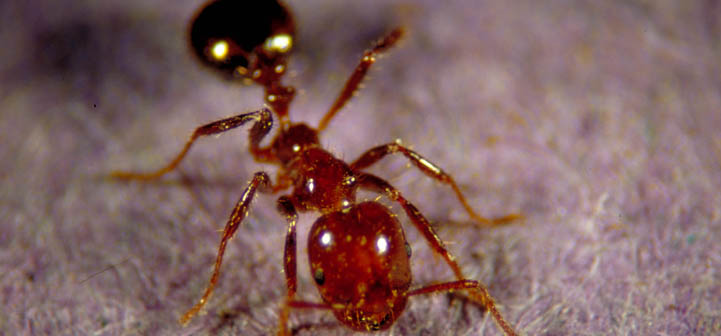Electrical Equipment and Utility Housing
Fire ants frequently infest electrical equipment. They chew on insulation, can cause short circuits, and can interfere with switching mechanisms. Air conditioners, traffic signal boxes, and other devices all can be damaged. Fire ants also nest in the metal housings that surround electrical and utility equipment. They frequently move soil into these units, which can cause corrosion, electrical short circuits, and other mechanical problems. For more information, see Ants and Electrical Equipment.
Note: For safety reasons, only electricians or licensed pest control operators should treat electrical equipment. Specialized products and training are necessary to treat these sites safely and effectively.
Treatment Program
- Step 1. Before treating any equipment, unplug the unit or turn off all electrical service. Use an individual mound treatment method with a faster-acting contact insecticide to eliminate colonies around electrical and plumbing casings and housings. Injectable aerosol products containing pyrethrins, or similar products, give rapid control. Hydramethylnon, abamectin, indoxacarb or spinosad baits applied near or on fire ant mounds provide control after about 1 week, even if the colony is located within the structure. Do not use liquid drenches, sprays, or products that may damage insulation around electrical fixtures. Treating a larger area around the electrical structure is optional, but will provide longer-term protection. Mound and area treatments are described in the section on Home Lawns and Other Ornamental Turf. Be extremely careful when applying pesticide around water systems and well heads to prevent contamination of wells and ground water. Once ants are eliminated, remove debris and soil from the equipment housings to reduce the possibility of short circuits.
- Step 2. To prevent ants from entering, treat the inside of equipment housings with specialty products labeled for such use, such as those containing propoxur (Rainbow® High Tech Insect Tag), permethrin (AntGuard®, Arinix®), synergized pyrethrins and silica gel (Stutton®JS 685 Powder), or dichlorvos (Hot Shot® No-Pest Strip). Some bait and bait station products also can be used inside equipment housings, but they provide little or no residual control.
Maintenance
After ants are removed from electrical equipment, prevent re-infestation and damage by sealing all sensitive electrical components, particularly those that are not insulated. Examples are plastic housings containing contact points of switches, relays and circuit breakers. Apply a long-residual contact insecticide around housings, making sure to avoid the electrical circuitry or components. Apply specifically labeled products to the housing itself or to the mounting pad (see Step 2 in the treatment program above).

